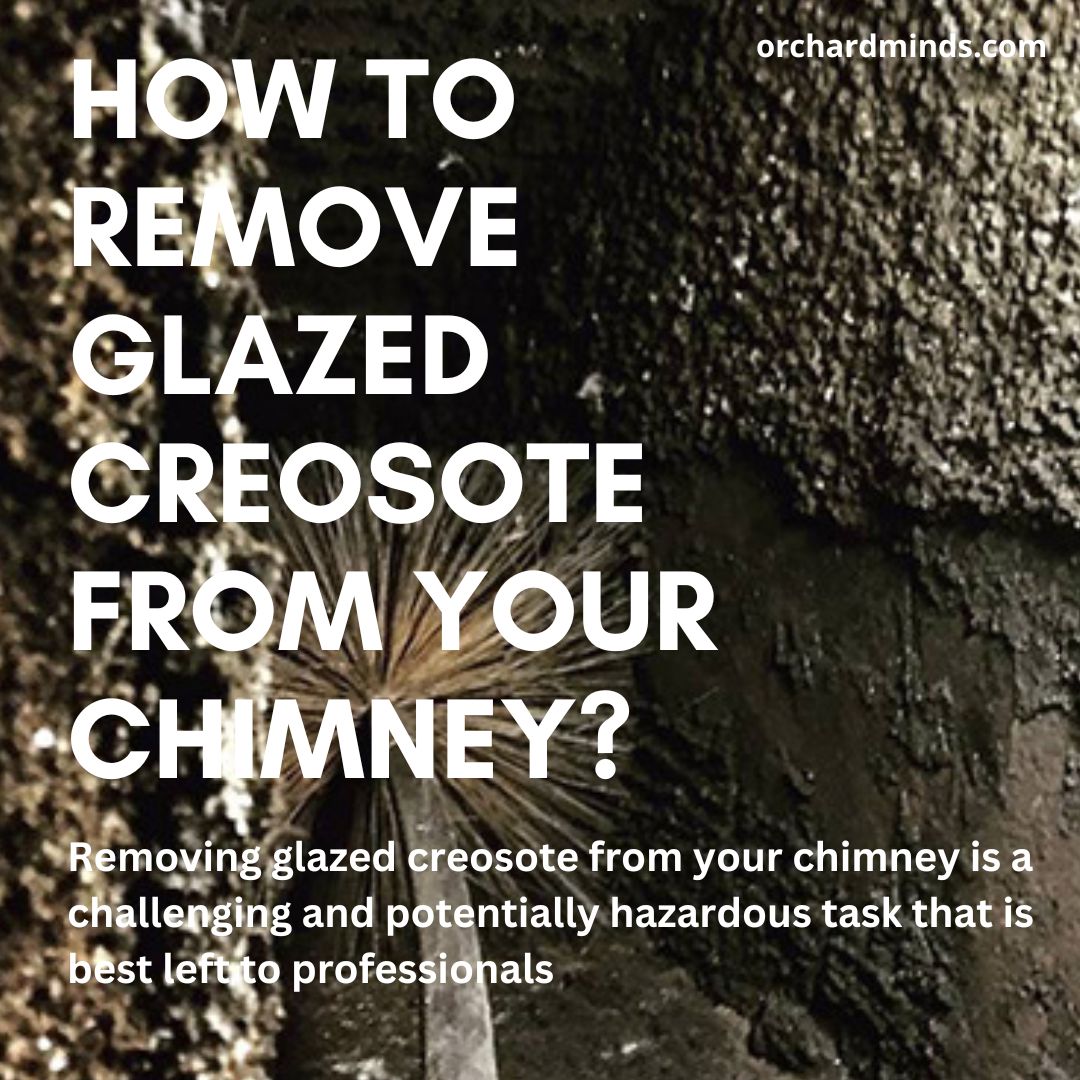Removing glazed creosote from your chimney is a challenging and potentially hazardous task that is best left to professionals. Glazed creosote is a hardened, tar-like substance that can form inside your chimney due to incomplete combustion of wood. It’s highly flammable and difficult to remove using typical chimney cleaning tools. A professional chimney sweeper has the specialized equipment and knowledge to safely remove glazed creosote without damaging your chimney’s structure. Attempting to remove it yourself can be dangerous and may lead to structural damage or even chimney fires. Regular chimney maintenance and inspections can help prevent the build-up of glazed creosote in the first place.
What is Creosote?
Creosote is a byproduct of burning wood or other combustible materials in a fireplace or wood-burning stove. It forms as a result of incomplete combustion when the smoke, gases, and particles from the fire are excellent and condense on the interior walls of the chimney. Creosote is a black or brown, tar-like substance that can accumulate over time and become highly flammable. It is the leading cause of chimney fires and poses a significant safety hazard.
About Level 3 Creosote
Level 3 creosote is the most hazardous and challenging form of creosote build-up. It is characterized by a hardened, shiny, and glazed appearance that adheres tightly to the chimney’s interior surfaces. Level 3 creosote is highly flammable and can be challenging to remove using conventional chimney cleaning methods. Removal often requires specialized equipment and expertise.
What is Glazed Creosote?
Glazed creosote is a highly flammable and hardened residue that forms on the interior walls of a chimney as a result of incomplete combustion of wood or other fuels. It has a glossy, glass-like appearance and is challenging to remove. Glazed creosote poses a significant fire hazard and requires professional attention for safe removal due to its stubborn and potentially dangerous nature.
How to Remove Glazed Creosote from Your Chimney
Removing glazed creosote from your chimney is a complex and potentially dangerous task. It’s best handled by professional chimney sweeps who have the necessary tools and experience to address the issue safely. They may use rotary brushes, power equipment, and chemical treatments to break down and remove the glazed creosote without damaging your chimney’s structure.
How to Prevent Creosote Build-Up
Preventing creosote build-up is essential for chimney safety. To minimize creosote formation, burn only well-seasoned firewood with low moisture content, maintain proper airflow in your fireplace or stove, and schedule regular chimney inspections and cleanings by professionals. Proper wood-burning practices and regular maintenance can significantly reduce the risk of creosote accumulation.
Step 1: Use Seasoned Firewood
Burn only well-seasoned firewood with low moisture content. Wood that is adequately dried for at least six months to a year burns more cleanly and produces less creosote.
Step 2: Maintain Proper Airflow
Ensure your fireplace or stove has adequate airflow by following the manufacturer’s guidelines for ventilation. Proper combustion reduces the formation of creosote.
Step 3: Install a Chimney Cap
Install a chimney cap with a spark arrestor on top of your chimney. This helps prevent debris, animals, and rain from entering the chimney, reducing the likelihood of obstructions and creosote build-up.
Step 4: Schedule Regular Inspections
Have your chimney professionally inspected and cleaned annually by a certified chimney sweep. They can identify and address creosote build-up and other potential issues before they become problematic.
Step 5: Monitor Smoke and Draft
Pay attention to the color of the smoke produced by your fireplace or stove. Excessive black or dark gray smoke is a sign of incomplete combustion and can lead to creosote formation. Ensure a strong draft for efficient smoke removal.
Step 6: Avoid Overloading the Fireplace
Avoid overloading the fireplace or stove with too much wood. Overloading can reduce airflow and increase the likelihood of incomplete combustion and creosote formation.
Step 7: Use Proper Burning Techniques
Follow best practices for burning wood, such as using smaller, dry kindling to establish a fire before adding larger logs. This helps ensure complete combustion and minimizes creosote production.
Step 8: Monitor Your Chimney Regularly
Keep an eye on your chimney for any signs of creosote build-up, such as dark, shiny deposits. If you notice these signs between annual inspections, contact a chimney sweep for a more frequent cleaning.
Glazed creosote is a dangerous problem that demands professional attention. Attempting to remove it on your own can lead to accidents, chimney damage, or even fires. Prioritize safety and consult a certified chimney sweep to ensure your chimney remains safe, efficient, and creosote-free. Remember that regular maintenance and proper wood-burning practices are vital to preventing creosote build-up in the first place.
FAQS about How to Remove Glazed Creosote from Your Chimney
What is glazed creosote, and why is it a concern?
Glazed creosote is a hardened, highly flammable residue that forms in chimneys. It poses a significant fire hazard due to its stubborn nature. Removing it is crucial for chimney safety.
Can I remove the glazed creosote by myself?
Removing glazed creosote is a complex and potentially hazardous task that should be left to certified chimney sweeps. They have the expertise, equipment, and safety measures needed for safe removal.
How often should I have my chimney inspected and cleaned to prevent glazed creosote?
It’s recommended to have your chimney professionally inspected and cleaned annually. Regular maintenance helps detect and address creosote build-up and other issues before they become problematic.
What are the signs that my chimney has glazed creosote build-up?
Signs include:
A shiny, glass-like residue on the chimney’s interior.
A strong, acrid odor during fires.
Decreased draft or airflow.
If you notice these signs, it’s essential to address the issue promptly.
Is it safe to use my fireplace or stove if I suspect glazed creosote build-up?
If you suspect glazed creosote, it’s not safe to use your fireplace or stove until a professional chimney sweep inspects and cleans the chimney. Using it could increase the risk of a chimney fire.
How do chimney sweeps remove glazed creosote?
Chimney sweeps use specialized equipment, including rotary brushes and power tools, to mechanically break down and loosen the glazed creosote. In some cases, chemical treatments may be applied to assist in the removal process.
Can I prevent glazed creosote build-up in the future after it’s been removed?
Yes, you can prevent future build-up by following proper wood-burning practices, using well-seasoned firewood, maintaining proper airflow, and scheduling regular chimney inspections and cleanings.
Is there a DIY solution for removing glazed creosote?
Attempting to remove glazed creosote without the proper equipment and expertise can be dangerous and may damage your chimney. It’s always recommended to hire certified chimney sweeps for this task.
How long does it take to remove glazed creosote from a chimney?
The time required for removal can vary depending on the extent of the creosote build-up and the specific methods used. It may take a few hours or longer for a thorough cleaning.
What should I do if I suspect glazed creosote in my chimney?
If you suspect glazed creosote, stop using your fireplace or stove immediately and contact a certified chimney sweep for an inspection and safe removal. Prioritize safety and avoid using the chimney until it’s cleaned and deemed safe.




1 Comment